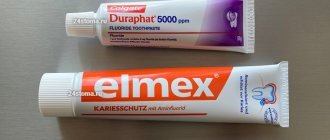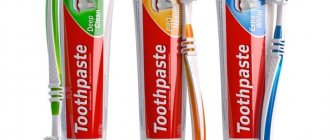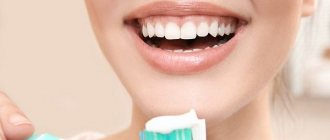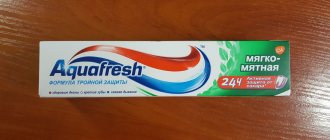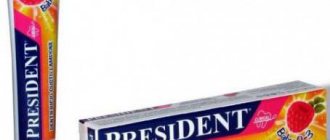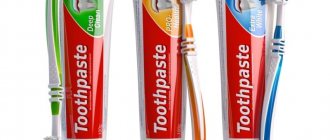Author of the article:
Soldatova Lyudmila Nikolaevna
Candidate of Medical Sciences, Professor of the Department of Clinical Dentistry of the St. Petersburg Medical and Social Institute, Chief Physician of the Alfa-Dent Dental Clinic, St. Petersburg
For many years, every second person in the street was convinced that a good toothpaste must certainly contain fluoride. Our grandparents stubbornly insisted on the importance of this element. But is fluoride really necessary in toothpaste, or does the harm of this microelement still outweigh its benefits? Let's try to figure it out.
What role does fluoride play in our body?
When answering the question of what fluorine is and why it is needed, it should immediately be explained that in its pure form this element is a rather poisonous and toxic gas. However, in products and hygiene products this substance is contained in the form of salts - sodium or calcium fluoride. In this form, it can bring tangible benefits to the body.
Our need for this element is no more than three milligrams per day.
So, what does fluoride do in toothpaste and why is it needed? First of all, it supports the natural mineralization of bone tissue, making it strong and at the same time elastic. Sufficient intake of this substance into the body promotes the growth of nails and hair, strengthening of dental tissues. In addition, it provides additional protection for the body from the effects of pathogenic microflora, improves immunity, and helps eliminate toxins and heavy metals.
What to use for oral care?
In order not to expose yourself to the risk of “eating” on dangerous substances, you should use natural toothpaste. These products do not sparkle with dazzling whiteness; they have natural yellowish and beige shades. If it includes herbs, it has a greenish color; if it contains coal, it is black.
Such hygiene products can protect against caries no worse than conventional toothpastes: they contain natural ingredients that destroy bacteria. These are sorbitol, borneol, clove oil, myrrh extract.
Why is this component so important for dental health - the benefits of the substance
The content of this element in oral care products protects against caries, makes enamel stronger, effectively removes plaque and fights pathogenic microflora. Let's take a closer look at the undoubted advantages of this component.
Prevention of caries
The enamel is constantly exposed to aggressive acids that are released with saliva. Food remains and other external factors lead to the formation of plaque, which gradually transforms into hard dental deposits, leading to the destruction of the enamel layer. As a result, a white spot first appears, which darkens and turns into a carious cavity.
The photo shows caries at the spot stage
Fluorine penetrates the crystal lattice of enamel, strengthens it and increases resistance to pathogenic microorganisms. It provides prevention of caries and prevents its further development, even if the disease is already at the white spot stage.
Decalcification protection
The substance promotes a process called “remyelination” - the transition of ions from the blood to the body’s tissues. Saliva, which is produced during food intake, leads to the opposite effect, that is, loss of calcium from dental tissues. When calcium and fluoride ions enter the oral cavity, they penetrate the crystal lattice of the enamel, strengthening it and preventing the destruction of hard tissues under the influence of saliva.
Strengthening enamel
The basis of enamel is calcium hydroxyapatite. By interacting with the microelement in question, this salt is converted into a new substance - fluorine hydroxyapatite. Thus, the microelement in question acts as a calcium protector, protecting it from the aggressive effects of acids in the oral cavity.
Prevention of the growth of pathogenic microflora
Pathogenic microorganisms that form plaque secrete special enzymes necessary for the breakdown of carbohydrates and their absorption. Our substance blocks the production of these enzymes, which prevents the further spread of pathogenic microflora.
Fluoride works great against plaque
“I have been using fluoride toothpaste for a year now and am very pleased with the results! About six months ago I bought myself an irrigator, so with them, every morning cleaning feels like after professional hygiene at the dentist. I recently had a preventive examination and there were no problems with the enamel. And I myself understand that sensitivity has not appeared, the teeth are white, without spots or irregularities. It seems to me personally that all this hysteria about the harm of such products is greatly exaggerated!”
AlesyaK., Moscow, from correspondence on the woman.ru forum
Stopping the secretion of lactic acid
This microelement blocks excess lactic acid synthesis, thereby effectively suppressing the growth of pathogenic microflora. This acid is produced by microorganisms during their life and reproduction. Products containing this component prevent this process, thereby providing additional protection for the enamel.
The best toothpastes for caries prevention
There are a huge number of manufacturers that produce pastes to protect against caries. We list the products recommended by dentists and chosen by customers:
- ROCS "Active calcium".
- Weleda with calendula.
- SPLAT Professional "Whitening Plus".
- Biorepair Plus Total Protection.
- CURAPROX Perio Plus Support.
- Apadent Perio.
- PERIOE Pumping Original.
- Marvis Orange Blossom Bloom.
- Dentissimo Complete care.
- Mirafluor C Toothpaste with Amine Fluoride.
Let us describe the main features of the pastes presented in the rating.
ROCS "Active calcium"
Contains a high concentration of calcium, which is built into the structure of tooth enamel due to a special activation system. After several weeks of using the paste, teeth become lighter. The main thing is that their resistance to caries increases. In addition to calcium, the composition includes phosphorus, silicon and magnesium, which ensure remineralization of enamel.
The paste contains xylitol, a natural component that prevents the proliferation of cariogenic microbes and maintains the balance of oral microflora. The abrasiveness of the composition is low, so this product can be used by people with increased sensitivity of the gums.
pros
- suitable for daily use;
- protects against bacteria and caries;
- saturates the enamel with minerals;
- very refreshing.
Minuses
slow whitening effect.
Weleda with calendula
A medicated toothpaste based on calcium carbonate, which effectively removes plaque from teeth and provides protection against caries. Contains calendula extract. It has an anti-inflammatory and calming effect. The paste does not contain mint; it contains fennel essential oil as a refreshing component. It can be used by people with individual intolerance to mint components. In addition, the paste contains no synthetic dyes, preservatives, flavors or bleaches.
pros
- anti-inflammatory effect;
- suitable for adults and children;
- not harmful if swallowed.
Minuses
- no fluoride in the composition.
SPLAT Professional "Whitening Plus"
SPLAT pastes are one of the most famous therapeutic and prophylactic dental care products. "Whitening Plus" is based on an innovative safe cleansing system. The composition includes rounded polishing particles, which, in combination with natural ingredients, lighten the enamel without harming it or the gums. The Polydon substance breaks down plaque in hard-to-reach places, making the surface of the teeth smooth.
The paste contains antibacterial components that prevent cariogenic microorganisms from multiplying. SPLAT Professional is ideal for tea and coffee lovers, as well as smokers. The fluoride content in the paste is 1000 ppm, which corresponds to a moderate therapeutic and prophylactic effect.
pros
- suitable for tooth sensitivity;
- cleans and polishes enamel;
- prevents plaque from settling.
Minuses
- Buyers note that this paste has no shortcomings.
Biorepair Plus Total Protection
A paste that reduces the hypersensitivity of enamel and gums, restores damaged dentin, creates a protective layer on the tooth surface, mineralizes the enamel and protects it from acids and microbes. Biorepair Plus Total Protection contains unique microRepair particles. Their composition is identical to hydroxyapatite, which is the basis of natural enamel and dentin. These particles have a needle-like structure, and therefore easily integrate into the surface of the tooth, filling cracks and restoring mineral balance. This ensures the prevention of caries.
pros
- the feeling of cleanliness lasts until the morning;
- polishes and cleans teeth;
- restores damaged areas of enamel;
- has an antibacterial effect.
Minuses
- high price.
This paste is used before and after dental surgery, for the treatment of periodontal diseases, to prevent gum damage, for tissue restoration and after the installation of orthodontic structures. CURAPROX Perio Plus Support also helps prevent caries. It is recommended to use it for no more than 6 months and as prescribed by a doctor.
The paste maintains the balance of oral microflora and has an antibacterial effect. After brushing your teeth, the process of plaque formation on the teeth slows down due to the formation of a protective film on the enamel. This ensures an anti-caries effect.
pros
- suitable for treatment and prevention;
- can be used after installing braces;
- has an antibacterial effect;
- does not change taste sensations;
- does not contain synthetic dyes.
Minuses
- high price;
- can be used for no more than six months.
This toothpaste is used not only to prevent caries, but also to treat it at the initial stage. The composition includes ocean salt, which has a calming effect. Apadent Perio is suitable for people with sore and bleeding gums. The paste contains antibacterial components that prevent the spread of cariogenic microbes. To strengthen the enamel throughout its depth, a bioactive mineral, which makes up human tooth enamel, is introduced into the composition. The paste has a pleasant minty-salty taste without the aftertaste of medicine.
pros
- suitable for dental hypersensitivity;
- pleasant to the taste;
- removes plaque and brightens enamel.
Minuses
- high cost.
PERIOE Pumping Original
One of the most effective toothpastes for caries prevention. It contains sodium fluoride in a concentration of 1400 ppm, which allows you to remove plaque, including deep plaque, destroy bacterial decay products and cleanse the oral cavity of harmful microbes even in hard-to-reach places. Fluoride helps remineralize enamel, making it more resistant to acids.
PERIOE Pumping Original comes in a convenient bottle with a dispenser: no need to squeeze the toothpaste out of the tube, just press the pump. So it is consumed more slowly. In addition, it foams well, so you need to apply it to the brush in a minimal amount. The bubbles formed during cleaning envelop the enamel, penetrating into the interdental spaces, which allows you to better clean your teeth from food and germs.
pros
- high fluoride content;
- convenient packaging;
- economical consumption.
Minuses
- high price.
Marvis Orange Blossom Bloom
Anti-caries paste based on calcium and fluoride. Has a soft creamy structure. Whitens teeth well and protects them from plaque. The paste is designed to maintain oral health and is used to prevent diseases of teeth and gums. The composition includes a citrus flavor of natural origin, providing a fresh effect. Marvis is produced in original retro packaging.
pros
- interesting tube design;
- minerals in the composition;
- pleasant citrus flavor.
Minuses
- Possible allergy to the citrus component.
Dentissimo Complete care
A paste made from plant extracts that have a calming effect. After using Dentissimo Complete, the sensitivity of the gums decreases and they stop bleeding. In addition, the paste restores the natural color of teeth. The composition includes calcium and hydroxyapatite, which replicates the structure of tooth enamel and strengthens it. The paste also contains extracts of geranium and eucalyptus. The first has an antiseptic effect, the second has a refreshing effect.
pros
- complex action;
- suitable for permanent use;
- contains calcium.
Minuses
- If you believe customer reviews, this product has no shortcomings.
Mirafluor C Toothpaste with Amine Fluoride
Toothpaste recommended for use to strengthen enamel and prevent caries. The main component of the composition is amino fluoride, which reacts with saliva and more effectively cleans teeth of plaque. This substance remains in the oral cavity for 3-5 minutes after brushing, providing fluoridation of the enamel.
The paste has a low degree of abrasiveness. It can be used by people with hypersensitive teeth and gums. There is no risk of damage if properly cleaned.
pros
- amino fluorides and calcium in the composition;
- suitable for tissue sensitivity;
- low degree of abrasiveness.
Minuses
- contains flavorings.
Before you start using medicated toothpaste, visit your dentist. He will select a product with a suitable composition. Do not try to cure caries and other oral diseases with it. Therapeutic paste is a supplement, not an alternative, to dental procedures.
You can order toothpaste on our website. In the catalog you will find other products presented in the rating.
What types of pastes with fluoride compounds are there?
Products that contain this component are usually classified as therapeutic and prophylactic. If the concentration is insignificant, then the product will be considered hygienic. Different salts of this component can be presented in different forms: amino fluorides, sodium fluorides, sodium monofluorophosphates and others. Pastes with a high content of the substance are recommended for use in courses.
Such pastes are usually therapeutic and prophylactic
As for the question of which toothpaste does not contain fluoride, the range of possible alternatives is less diverse. Products that do not contain fluoride usually contain other active ingredients, which are also characterized by their own advantages and disadvantages.
Pros of fluoride toothpastes
Many people specifically choose hygiene products with fluoride to strengthen their teeth and prevent the development of caries. Indeed, in some cases, this element protects the enamel from the action of harmful bacteria and strengthens it. Under the influence of fluoride, less acid is released, which affects the enamel. Therefore, anti-caries toothpastes often contain fluoride.
The main benefits of fluoride toothpastes include:
- antiseptic effect;
- improvement of metabolism;
- improvement of the remineralizing effect of saliva;
- stimulation of the salivary gland;
- inhibition of the transformation of soft plaque into tartar.
Can it be used by children?
When choosing a product for children's teeth, it is important to assess the possible risks - whether it will bring more benefit or harm in your particular case. And to do this, you should first show your child to the dentist and consult with him about purchasing the most suitable toothpaste.
You should also take into account that most young children swallow part of the paste during brushing, and this can cause undesirable consequences, including stomach and intestinal upset. So, the concentration of the component should not exceed 1500 ppm1 - this is how this indicator will be indicated on the packaging, indicating how much of the substance is contained in this paste.
For a child, you need to choose only children's toothpaste
However, modern manufacturers also produce fairly effective and safe fluoride products for children, which provide excellent prevention of childhood caries. But it can only be used in courses and according to the indications of a pediatric dentist.
Antibacterial properties of the component
The periodontium consists of the gums, the cement covering the root of the tooth, the bone tissue of the alveolar process and the ligament that holds the tooth in the bony alveolus. Inflammatory periodontal diseases are most often caused by the action of pathogenic microorganisms.
As an antibacterial component, triclosan is used in anti-inflammatory toothpastes to destroy microbes that multiply in areas of inflammation. In addition, during inflammation, specific substances – inflammatory mediators – accumulate in the tissues of the body.
Normally, they are constantly present in tissues, but during inflammatory reactions the concentration of mediators increases sharply. They increase vascular permeability, which is why redness and swelling appear around the pathological focus.
Due to the release of the liquid part of the blood from the blood vessels into the tissues, pain occurs as the exudate compresses the nerve endings. Local and general increase in temperature is also a consequence of the work of mediators.
The component inhibits the action of mediators and prevents the development of signs of inflammation. Experiments have proven that the use of products with triclosan is effective against gingivitis and other inflammatory diseases of the tissues surrounding the tooth.
What harm could it do?
Fluoride is found not only in hygiene products, but also in food and even tap water. The acceptable daily intake is approximately 3 mg. But in certain regions and localities, the content of the substance in running water greatly exceeds the norm, which can lead to an overdose of this microelement, especially in children.
So, why is it considered that such pastes are harmful, and why is an excess of this substance dangerous? Let's start with the fact that the element in question is characterized by toxicity and the ability to accumulate in tissues, including tooth enamel - this is one of the reasons why such products cannot be used constantly.
When this happens, a pathology called fluorosis develops. White spots appear on the teeth, after which they become noticeably darker, literally corroding hard tissue. This condition requires treatment by a dentist. In such cases, specialists usually prescribe remineralization and fluoridation, as well as the use of special hygiene products that help restore damaged tissue.
An excess of the substance in the body can cause fluorosis
Purpose and features of triclosan
The component was first obtained in 1965 by Swiss scientists. The drug belongs to the chlorophenolic group. It is widely used in hygiene products and household chemicals as an antibacterial substance. After the introduction of this component, many studies were conducted to study its safety in relation to human health.
Due to its antibacterial properties, triclosan is active against a wide range of microorganisms. The effectiveness of its use is confirmed by many years of practical experience in using it in hygiene products. The component interacts well with other components of dental products, which makes it possible to create complex formulations. Even in low concentrations it does not lose its properties.
Triclosan acts on the cytoplasmic membranes of various microorganisms, thereby effectively neutralizing pathogenic fungi and bacteria. A significant disadvantage is the destruction of not only negative, but also beneficial microflora.
Substance poisoning - symptoms
A sufficient, but not excessive intake of this substance into the body helps strengthen the enamel and improve the condition of the teeth. However, overdose can cause serious damage. Usually in such cases they talk about the development of fluorosis. Among the most common varieties of this pathology, experts in the field of dentistry distinguish spotted, streaked, chalky-speckled, erosive and destructive forms. Let's look at them in a little more detail:
- spotted - involves the formation of small light spots on the enamel, which can merge with each other, forming one large spot,
- streaked - light stripes of different shapes appear on the incisors, which can also combine to form fairly large strokes,
- chalky-mottled - the surface of the teeth becomes dull and yellowish, while many dots and specks appear on its surface. Pathological abrasion of the enamel is noted, due to which the dark color of dentin begins to appear,
- erosive – leads to the formation of numerous specks, but primarily affects the chewing surface of the teeth,
- destructive – dental tissues become fragile and quickly break down.
The photo shows dental fluorosis.
An excess of fluoride in the body also affects the condition of the skeletal system. One possible complication is osteoporosis, in which the bones become soft and calcium is quickly washed out of them. Pathological changes occur in the joints, causing ankylosis to develop. In advanced cases, the liver and kidneys suffer.
Harm of triclosan to the body
It has been proven that triclosan, when entering the body, has a number of undesirable effects on various organs and systems.
Hormonal imbalance
The substance, once on the skin as part of creams and ointments, easily passes through the skin barrier, as it is a fat-soluble substance. It enters the bloodstream and behaves like the female sex hormone estrogen. This replacement therapy disrupts hormonal levels and leads to gonadal cancer in men and women. Children may experience early puberty.
Thyroid dysfunction
Triclosan metabolic products interfere with the normal functioning of the thyroid gland. This gland regulates all types of metabolism, is responsible for the formation of energy and the proper development of the body.
Development of heart and vascular diseases
The component changes the contractility of muscle fibers, including the main muscle in the body - the heart.
Destruction of beneficial microflora
The component affects both pathogenic forms and resident microflora of the body. Beneficial bacteria, necessary for a balanced internal environment, die from the action of the substance.
Weakened immune system
To form a strong immune system, the body needs to deal with natural “dirt.” The immune system will then activate its defense systems and produce antibodies. People who have been using personal hygiene products with antibacterial components since childhood are more susceptible to infectious diseases, since their immunity does not develop sufficient resistance to environmental factors.
With prolonged exposure to a substance, pathogenic bacteria develop resistance, or tolerance, to the substance. When an infectious disease develops in the body, the treatment of which requires antibiotics, microorganisms may exhibit the same resistance, and therapy will be ineffective.
Harm to fetal development
According to some studies, triclosan negatively affects the health of the fetus in the womb. It reduces blood flow to the fetal brain, which leads to oxygen deficiency of the organ, and this leads to a disruption in its development.
Poisoning of the body
When interacting with tap water, the substance combines with chlorine. As a result, special compounds are formed - dioxides, which are absorbed into the blood and have a toxic effect on the body.
In addition to its direct effect on the human body, triclosan, when released into the environment with water, pollutes water bodies and soil, and poisons plants and animals.
In Russia you can easily purchase products containing this substance. However, in 2016, US authorities issued a ban on the sale of soap containing triclosan as an antibacterial component. The ban does not apply to other products, including pastes.
How to remove excess substance from the body
There are methods that allow you to remove excess fluoride from the body, but they give the desired result only if the pathology is in the initial stages of its development. Here are the main ways to combat intoxication with this element:
- iodine – promotes the excretion of the substance in the urine, so it is recommended to increase the consumption of foods rich in this component: strawberries, lingonberries, beans, potatoes,
- boron – also effectively removes fluoride and is found in high concentrations in honey, nuts, dates, avocados, prunes,
- selenium – blocks the activity of an excess element, found in sufficient quantities in Brazil nuts,
- dry sauna – helps remove accumulated toxic substances through sweating.
Consumption of iodine-containing products helps remove the substance from the body.
But before moving on to measures to remove the substance, it is necessary to limit its entry into the body. For a while, you will have to give up foods with a high content of it, switch to clean bottled water, and stop using fluoride-containing hygiene products.
HOW TO PROTECT YOUR BODY FROM THE EXPOSURE OF FLUORIDE WHEN BRUSHING YOUR TEETH
To ensure that active fluoride ions do not cause harm to the body, you must adhere to a few simple rules:
- Study the packaging of the toothpaste when purchasing, pay attention to which fluoride compound is included in its composition and in what concentration.
- Before using a fluoridated product, you should consult with a specialist ; perhaps the level of fluoride in the water in the region where you live is sufficient and such a paste will only cause harm.
- Children under 6 years of age should not use fluoridated toothpaste . At this age, children do not fully have the skills to brush their teeth, which can cause them to swallow large amounts of hygiene products.
- When planning a vacation in other regions, you should pay attention to the level of natural fluoride content in drinking water. If the content is normal or high, you should stop using fluoridated toothpastes during the rest period.
- To minimize the amount of fluoride that enters the body when brushing your teeth, the amount of toothpaste should not exceed the size of a small pea.
In addition to pastes, fluoride is included in rinses, special gels and chewing strips, as well as dental preparations that are used in a professional office. Therefore, the choice of a method for preventing the development of caries should be left to the dentist and strictly adhere to all his recommendations.
Source
Tips for choosing dental hygiene products
In order for daily cleaning to be as effective as possible, you need to carefully consider the choice of toothpaste. It is best to consult your dentist in this matter and give preference to the product that is most suitable for your specific case. All toothpastes on the market can be divided into three independent categories:
- hygienic – used for daily cleansing of enamel and aromatization of breath,
- medicinal – they contain active additives that, when interacting with damaged or inflamed tissues of the oral cavity, help stop pathological processes,
- therapeutic and prophylactic - also contain active components, but in lower concentrations, prevent the development of many dental diseases - teeth and periodontal tissues.
When choosing a toothpaste, carefully study its composition. You need to
choose which toothpastes contain fluoride, or give preference to a product without this component, taking into account the current condition of the teeth and oral cavity. The dentist will help you with this after examining and assessing the current condition of the enamel.
Indications for the use of fluoride pastes
Of course, in some cases, toothpastes with fluoride will be useful to patients, but, as we have already said, only a dentist should prescribe them. The specialist will assess the condition of the enamel and oral cavity, and then determine whether the teeth have enough fluoride and what kind of toothpaste they need.
Therapeutic toothpastes with calcium and fluoride are indicated for use if the patient has:
- signs of dental demineralization;
- poor enamel resistance to acids;
- fragility of teeth, tendency to chip;
- minor signs of caries.
The fluorides contained in such toothpastes create a thin protective layer on the crowns. All substances hazardous to enamel do not penetrate it and their negative impact is reduced several times. Incoming fluoride, when it is deficient in the body, slows down the proliferation of bacteria and, accordingly, the development of caries. The likelihood of gum inflammation is also reduced.
Rating of the best products containing fluoride
Today on pharmacy shelves you can find a wide variety of different brands of dental and oral hygiene products. Let's take a closer look at which pastes contain this substance and are considered the most popular in their segment.
Paradontax for healthy teeth and gums
According to the manufacturer, the paste helps restore gums and reduce signs of inflammation and bleeding. The presence of fluoride in its composition ensures high-quality plaque removal and caries prevention. According to reviews, within just a few days of using Paradontax, gums acquire a healthy pink tint, and teeth become noticeably whiter.
Colgate for caries protection
One of the most popular companies today that produces various hygiene products to keep the oral cavity clean and healthy. Fluoride paste helps prevent the development of caries in the initial stages, effectively remove plaque and prevent stone formation.
Blend-a-med with active fluorine in its composition
This option is optimal in terms of price and quality ratio. The product is affordable and quite effective - it successfully removes plaque, eliminates unpleasant odor, and prevents gum inflammation. You need to understand that using a paste for daily use is unlikely to achieve a perfectly snow-white smile, but it will definitely help with plaque and bacteria.
Sensodyne against hypersensitivity
This remedy effectively combats hyperesthesia - increased sensitivity of enamel, especially during temperature changes and mechanical irritation. In addition, it perfectly fights the first signs of caries. Before you start using any product that contains high fluoride, it is best to talk to your dentist. Constant use of such pastes is undesirable.
The history of fluoride in toothpastes
Fluoride was first used in toothpastes more than 100 years ago, in 1914 in the USA. At the beginning of the 20th century, scientists found that this element is an excellent protection against caries and its use reduces the rate of tooth decay by an average of 30-45%. Under the influence of fluorine, enamel became resistant to acids and more durable.
Why is fluoride needed in toothpaste?
Surprisingly, the same element can be both healing and destructive to the body. And fluoride is just that: the substance can both restore and strengthen tooth enamel, and cause irreparable harm to it. It is thanks to fluoride that the strength of bone tissue in the body is maintained; this element plays a key role for the health of hair, nails and teeth. Fluoride is very important in the growth and development of a child: without it, his skeleton does not develop normally.
In addition, fluorine has a beneficial effect on metabolism: without this element, the body cannot remove heavy metals. The substance also helps absorb iron and supports immunity.
When there is a lack of fluoride in the body, bones and teeth are the first to suffer. Bones bend, become brittle and brittle, and in the event of a fracture they heal very slowly. With a lack of fluoride, the enamel gradually becomes thinner, it is increasingly affected by plaque bacteria, and caries develops faster and faster.
In fact, it is not difficult to provide the body with its daily requirement of fluoride. Products high in this substance include:
- a variety of fruits, such as grapefruits and apples;
- nuts;
- dairy products;
- various types of meat (especially liver);
- various vegetables - pumpkin, spinach, potatoes;
- buckwheat and oatmeal porridge;
- honey;
- any types of tea.
By drinking enough water per day and eating right, you can provide yourself with fluoride. Therefore, the need for toothpastes with fluoride should only be determined by a dentist. As a rule, fluoride products are prescribed to smokers and people who abuse coffee.
How to brush your teeth correctly
Choosing the right toothpaste is only half the battle. To achieve a visible and tangible effect, it is important to learn how to properly carry out daily cleaning. Let us remind you that the main rule of maintaining oral hygiene is regular cleaning of the enamel with a brush and paste. As for the technique of its implementation, experts in the field of dentistry provide several more important recommendations in this regard:
- from the outside, the teeth must be cleaned with vertical sweeping movements, starting from the gums (if you brush in a horizontal direction, you can damage the enamel),
- similar vertical movements should be used to clean the inner surface,
- posterior molars can be cleaned using horizontal movements, paying special attention to the chewing surface,
- Next, you should move on to the tongue - its surface must be cleaned, since it is on it that the largest number of bacteria accumulate.
It is better to learn the correct cleaning technique from childhood. This is one of the reasons why, after the appearance of the child’s first teeth, it is imperative to show him to the dentist for preventive care. Even if you are not sure as an adult that you brush your teeth correctly, a professional dentist will definitely help you with this.
Sources
- https://www.health.harvard.edu/blog/are-antibacterial-products-with-triclosan-fueling-bacterial-resistance-2019080617473
- Weatherly LM, Gosse JA Triclosan exposure, transformation, and human health effects // J. Toxicol Environ Health B Crit Rev. 2017; 20(8): 447–469. doi: 10.1080/10937404.2017.1399306
- What is triclosan? // Medvyvod.ru. 2014. February 15. URL: https://www.medvyvod.ru/medical_news/3098.html
- Detusheva E.V. Modeling a biofilm in bacteria on a solid nutrient medium and studying the patterns of formation and resistance to triclosan: dissertation. ...cand. biol. Sci. Obolensk, 2016. 158 p.
- Campbell L., Zirwas MJ Triclosan. // Dermatitis. 2006. Vol. 17(4). P. 204-207.
- Shaofang Cai, Jiahao Zhu, Lingling Sun, et al. Association between urinary triclosan with bone mass density and osteoporosis in US adult women, 2005-2010 // J Clin Endocrinol Metab. 2019; 104(10): 4531–4538
- Dhillon GS, Kaur S, Pulicharla R, Brar SK, Cledón M, Verma M, Surampalli RY. Triclosan: current status, occurrence, environmental risks and bioaccumulation potential // Int J Environ Res Public Health. 2015. May 22; 12(5): 5657–5584
- Vosátka R, Krátký M, Vinšová J. Triclosan and its derivatives as antimycobacterial active agents // Eur J Pharm Sci. 2022. Mar 1; Vol. 114. P. 318–331
- Chigrinets S.V., Bryukhin G.V. The impact of endocrine disruptors on the quality of ejaculate in men // Andrology and genital surgery. – 2022. – T. 19. – P. 42–47
- https://www.fda.gov/consumers/consumer-updates/5-things-know-about-triclosan
- The Svoboda factory has resumed production of soap with triclosan // Cosmetic-industry.com. 2022. April 3. URL: https://cosmetic-industry.com/fabrika-svoboda-vypustit-polmilliona-shtuk-myla-s-triklozanom-do-kontsa-mesyatsa.html
Choosing a brush - expert advice
Another mandatory attribute of daily oral care is a brush. Her choice also needs to be taken seriously, and dentists give the following advice on this matter:
- the head should not exceed 3 cm in length,
- it is better to choose models with artificial bristles, since natural ones create favorable conditions for the growth of bacteria,
- The ribbed back surface of the head is designed to clean the tongue - there is no need to additionally purchase a special scraper.
It is important to choose the right toothbrush.
If you have sensitive gums that are prone to inflammation and bleeding, it is better to give preference to a brush with soft bristles. But keep in mind that it will be worse at cleaning the enamel from plaque, so the procedure must be especially intense. Hard brushes are intended to be used according to indications - otherwise they can injure the gums and enamel and do more harm than good.
Triclosan in cosmetics and hygiene products
Antibacterial soaps and body washes and fluoride toothpastes are considered over-the-counter medications, according to FDA guidelines at www.fda.gov [10]. If an over-the-counter drug contains triclosan, it must be listed as an ingredient on the label in the “drug facts” box. If a cosmetic product contains triclosan, it must be included in the list of ingredients on the product label.
So, abroad, manufacturers of products with triclosan are required to indicate the presence of the component on the product packaging, in the list of ingredients or in other accompanying documents.
Most recently, in light of the epidemiological situation, the SVOBODA factory resumed production of toilet soap with triclosan. And this is clearly stated on the packaging of the bar soap. Many proponents of using triclosan products will notice and choose this product. Others who are wary of using a cosmetic product with triclosan will choose another product, and thus ethical standards of interaction with the end consumer will be observed.
Please note that triclosan can cause dry skin. A solution can be found in the use of additional softening components. Thus, the Arlasilk product from Croda (a phospholipid from coconut oil), when added to the formulation, can reduce the percentage of triclosan introduced and provide protection against dryness while maintaining antimicrobial activity.
Additional oral care tips
Even with systematic brushing of teeth twice a day and regular rinsing after meals, any dental problems cannot be completely ruled out. To further protect yourself from caries and other troubles, it is better to limit the consumption of sweets and carbonated drinks, coffee and smoking - all of these are the main provocateurs of pathological processes in the oral cavity.
Try to give up bad habits
You must remember to use fossa threads, and also visit the dentist’s office regularly - at least twice a year. If you notice suspicious symptoms, you should immediately consult a doctor - this is the only way to detect any problem in its very beginnings, and therefore quickly resolve it.
- According to WHO.
conclusions
In the context of the COVID-19 coronavirus pandemic, the use of additional hygiene products with antibacterial properties has become very relevant. Triclosan, as a component with high antibacterial efficiency, has a chance to be used in this group of products. At the same time, you should not forget about its possible side effects on the human body, take into account all recommendations when manufacturing cosmetic products with this component and indicate the presence of the ingredient on the packaging.
Alternative to fluoride
Toothpaste containing calcium is offered as an alternative to fluoride. This is especially true for regions where there is a high amount of fluoride in the water.
Various calcium compounds are used for this purpose:
- fluorides of potassium, aluminum, sodium;
- olaflur;
- monofluorophosphate.
Consumers are advised to alternate between pastes containing fluoride or calcium.
Which pasta should you choose?
Dentists recommend special formulations for use, which must be selected depending on several factors:
- The age of the patient and the condition of his teeth.
- Quantitative content of fluorine elements in water used for cooking and in everyday life.
- Assortment of toothpastes sold in retail chains.
- A list of problems that can be solved by using cleaning compounds.
The assortment of cleaning pastes for the older age group includes the following brands:
- Splat-Maximum (Russia).
- Splat-Biocalcium (Russia).
- President unique (Italy).
- Rox (Russia).
- Asenta (Russia).
Children's pastes:
- Teeth gel Weleda (Germany).
- Splat junior (Russia) .
- Rocs Pro baby (Russia).
The role of fluoride
Various fluoride compounds are added to cleaning compositions. The most common are:
- sodium fluoride;
- fluorosilicate;
- fluorosilicic acid.
Fluoride consumption by a person during the day should not exceed the norm of 1.5-3.0 mg, taking into account the role of the element’s effect on the body’s carbon and fat metabolism.
